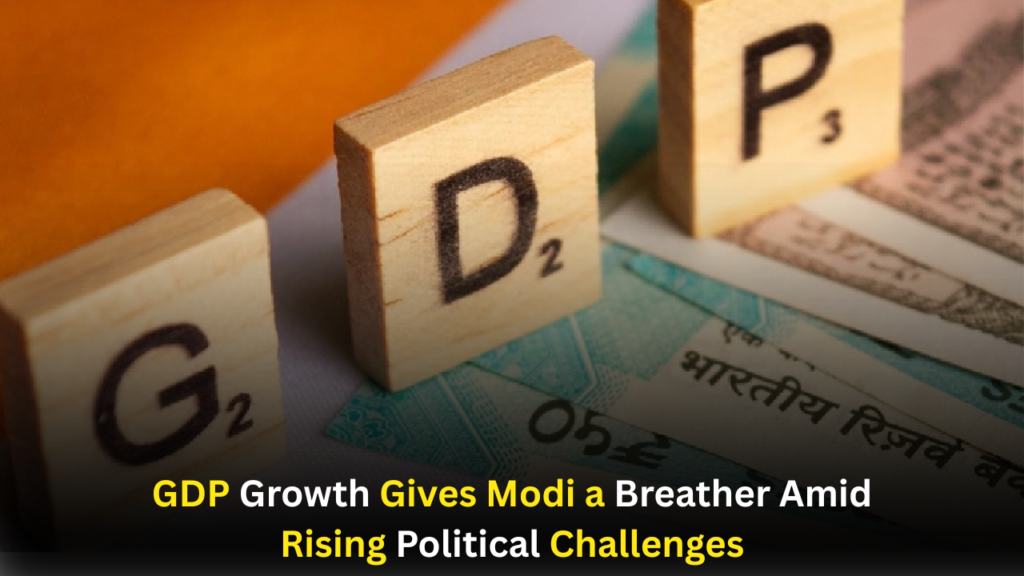
India
Introduction
India GDP Growth 2025 : India’s economy demonstrated remarkable resilience in the fourth quarter of FY2024-25, registering a growth rate of 7.4%. This performance exceeded analyst expectations and provided a significant boost to the annual GDP growth, which stood at 6.5% for the fiscal year.
As the nation continues to recover from a depression, India’s GDP increased 7.4% in the most recent quarter, quicker than anticipated.
The expansion in manufacturing and construction, along with an increase in tax revenues, drove the result, which was higher than the corrected 6.4% from the previous quarter. It exceeded the 6.7% prediction made by Reuters’s survey of economists.
Prime Minister Narendra Modi’s administration, which had been under pressure after a severe downturn last year, will be buoyed by the economic recovery in the three months leading up to March.
Since then, Modi has tried to boost consumption by lowering taxes on the middle class, which was squeezed by a combination of stagnant wages, growing expenses, and mounting household debt.
But Friday’s report also highlighted how weak the economy has been over the last fiscal year, which ended in March. According to preliminary government estimates, GDP growth decreased to 6.5% from 9.2% the year before.

Quarterly Performance Overview
Q4 FY2024-25 Highlights
- GDP Growth: 7.4% year-on-year, the highest in the past four quarters.
- Gross Value Added (GVA): Increased by 6.8%, indicating robust underlying economic activity.
- Nominal GDP: Rose by 10.8% year-on-year in Q4, reaching ₹88.18 trillion.
Sectoral Contributions
Construction and Manufacturing
- Construction Sector: Experienced a significant growth of 10.8% in Q4, up from 7.9% in the previous quarter.
- Manufacturing Sector: Grew by 4.8% year-on-year in Q4, compared to a revised 3.6% in the preceding quarter.
Services Sector
- Public Administration, Defence, and Other Services: Expanded by 8.9% over the year.
- Financial, Real Estate, and Professional Services: Grew by 7.2% annually.
Agriculture
- Agricultural Sector: Showed a notable improvement with a growth of 5.4% in Q4, up from 0.9% in the same quarter the previous year.
Policy Implications
Monetary Policy
The Reserve Bank of India (RBI) is anticipated to cut the benchmark interest rate by 25 basis points to 5.75% in its upcoming meeting on June 6, 2025. A further rate cut is expected in August, potentially bringing the rate down to 5.50%. These measures aim to support economic growth amid global uncertainties.
Fiscal Policy
The government’s focus on infrastructure development and capital expenditure has been instrumental in driving growth. Tax cuts introduced to stimulate consumption have also contributed to the economic momentum.
Future Outlook
Projections for FY2025-26
- RBI’s Forecast: Real GDP growth projected at 6.5% for FY2025-26, with quarterly estimates ranging from 6.3% to 6.7%.
- IMF’s Projection: Expects India’s economy to grow by 6.2% in 2025.
Challenges Ahead
- Global Economic Slowdown: Potential to impact export demand and investment flows.
- Private Sector Investment: Remains subdued, with private sector expenditure falling to a 10-year low of 33% in the last fiscal year.
To achieve Modi’s objective of achieving developed status by 2047, the centennial of India’s independence from British rule, many analysts estimate that the country’s GDP must expand at a rate of 8%.
The new normal for us structurally at the moment is 6 to 6.5% growth, said to Madhavi Arora, chief economist of Mumbai-based Emkay Global.

“It’s a respectable figure if we’re at that level when there’s going to be a worldwide recession. “We really need to pull up our socks if we want more,” she remarked.
India continues to be the largest country with the greatest rate of economic growth, and according to IMF estimates, its GDP might reach $4.2 trillion this year, matching Japan’s.
Conclusion
India’s robust GDP growth in Q4 FY2024-25 underscores the economy’s resilience and the effectiveness of policy measures aimed at stimulating growth. While challenges persist, particularly on the global front, the domestic economy shows strong fundamentals that could support sustained growth in the coming years.



